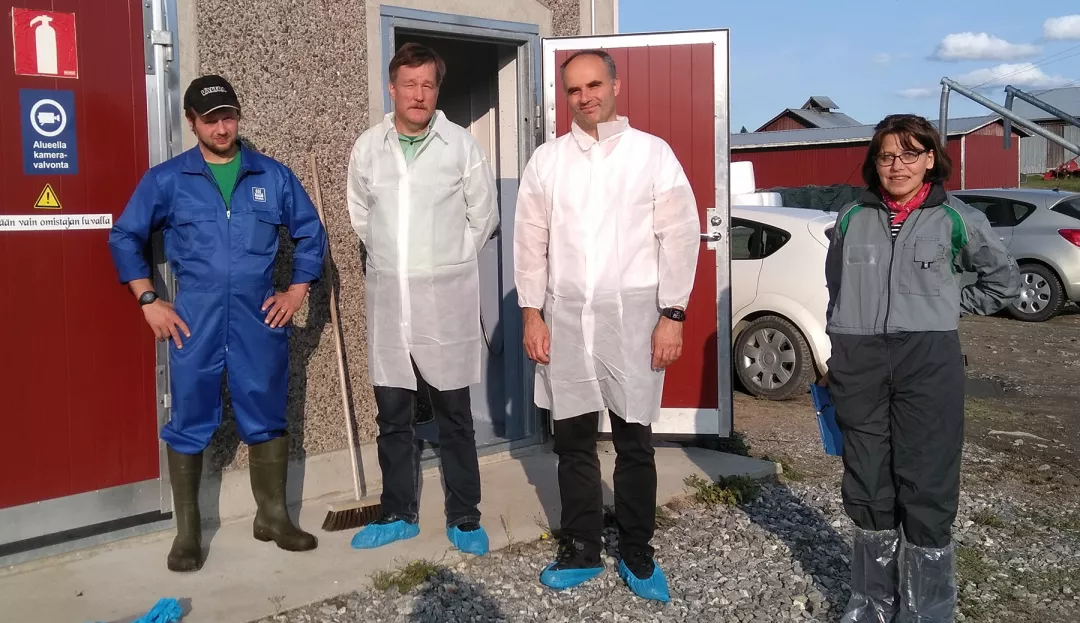Inspirational ideas: biosensors in dairy farming
- Innovation, knowledge exchange & EIP-AGRI
- Agricultural Productivity
- Fostering Knowledge & Innovation
- Networking
Dairy farms in Estonia and Finland have some fundamental differences. Since 2018, Operational Group (OG) MAVAS has been working in parallel with Finnish OG SMARTFEED. They are both looking into the use of biosensors in daily dairy farming.

Over the last 20 years, Estonia and Finland have both modernised their agriculture, particularly in the dairy sector. Production and effectiveness have been optimised. However, dairy farms in the two countries have some fundamental differences. The largest Estonian dairy farms are managed like industrial enterprises with up to 2 000 cows per farm. In Finland, dairy farms, although very modern, are typically family-run and very rarely have over 500 cows.
Dairy farmers and industry in these two countries can learn a lot from each other and form an effective duo for developing dairy farming production and practices even further
The Estonian Dairy Cluster (EDC) leads this OG and over-the-border cooperation. Since 2018, MAVAS has been working in parallel with Finnish OG SMARTFEED, coordinated by the University of Oulu. They are both looking into the use of biosensors in daily dairy farming.
MAVAS – Estonia
Earlier in 2017, the EDC commissioned the development of a technical platform for a biosensor system to detect the most common pathogens in milk which cause mastitis. The sensors can identify the pathogens within 20 minutes. The MAVAS OG has been set up as a second phase of this development work and it aims to develop an express prototype and test it on farms.
This OG involves members of the EDC and scientific partners such as TorroSen Ltd, Animal Breeders Association of Estonia, the Estonian University of Life Sciences and the Competence Centre on Health Technologies.
Hardi Tamm, who is also chairman of EDC, explains: “The project involves comparing the biosensor results with accredited laboratory methodologies, optimising measuring methods on different farms, preparing a biosensor prototype and testing analysis equipment on farms and determining the pathogen count in mastitis-affected milk. The different types of microbes causing mastitis are identified on a farm-by-farm basis. Prototype sensor devices are placed on farms to map pathogen distribution patterns. This enables farmers to test the equipment and give feedback concerning its use under real farm conditions.”
SMARTFEED Finland
SMARTFEED, the Finnish OG, aims to develop methods, tools, analytics and data transfer to create a system for monitoring silage quality, and energy and protein nutrition balance in dairy cows on farms. “The ultimate aim is to increase efficiency, productivity and competitiveness of the farms by reducing feed costs. Rapid, semi-automated measurement systems also reduce the labour needed,” explained Pekka Kilpelainen, the project manager of SMARTFEED.
The project will develop and test several tools based mostly on biosensors to monitor dairy cow wellbeing and nutritional balance. These will enable fast silage and fodder sampling and analytics for farms and also measurement data storage and utilisation.
For the Finnish OG, it is very important to engage farmers as central actors in the project and active participants in international collaboration. Then information will be disseminated directly to them and they are given the opportunity to learn from their peers.
The members of this Finnish OG include the Unit of Measurement Technology at the University of Oulu, ProAgria Rural Advisory Services (Finnish network of rural consultants), Finnish companies MTech Digital Solutions and SEMES (manufacturer sof silage sampling equipment), eight dairy farms and one veterinarian.
Two Operational Groups join forces
Eventually, both sides plan to pilot their developments in farms from their countries to assess the capability and effectiveness of the biosensors in different conditions. “We found this cooperation useful because the combination of sensors helps to find the optimal solutions. Multilateral transfer of knowledge and sharing of experience is not only between scientists; it is a positive outcome of cooperation. We strongly recommend the cross-border practice to improve European competitiveness,” Mr Tamm added.
At the end of April 2019, SMARTFEED visited their Estonian colleagues. The group included farmers, researchers, representatives of the rural advisory organisation ProAgria and a municipal veterinarian. The farmers actually were most eager to ask questions when SMARTFEED visited three Estonian farms: a smaller organic farm of 200 cows, a farm of 2 300 cows and a medium-sized farm of 700 cows. The Finnish students of veterinarian sciences from the Estonian University of Life Sciences acted as interpreters helping farmers to communicate. Scientists and administrative staff of the projects discussed future joint research and development plans. Finally, they all attended the largest Baltic agricultural exhibition, Maamess, in Tartu.
Translation courtesy of the National Rural Network (NRN) Slovakia. Read more EIP-AGRI inspirational ideas in Slovak on the NRN website.